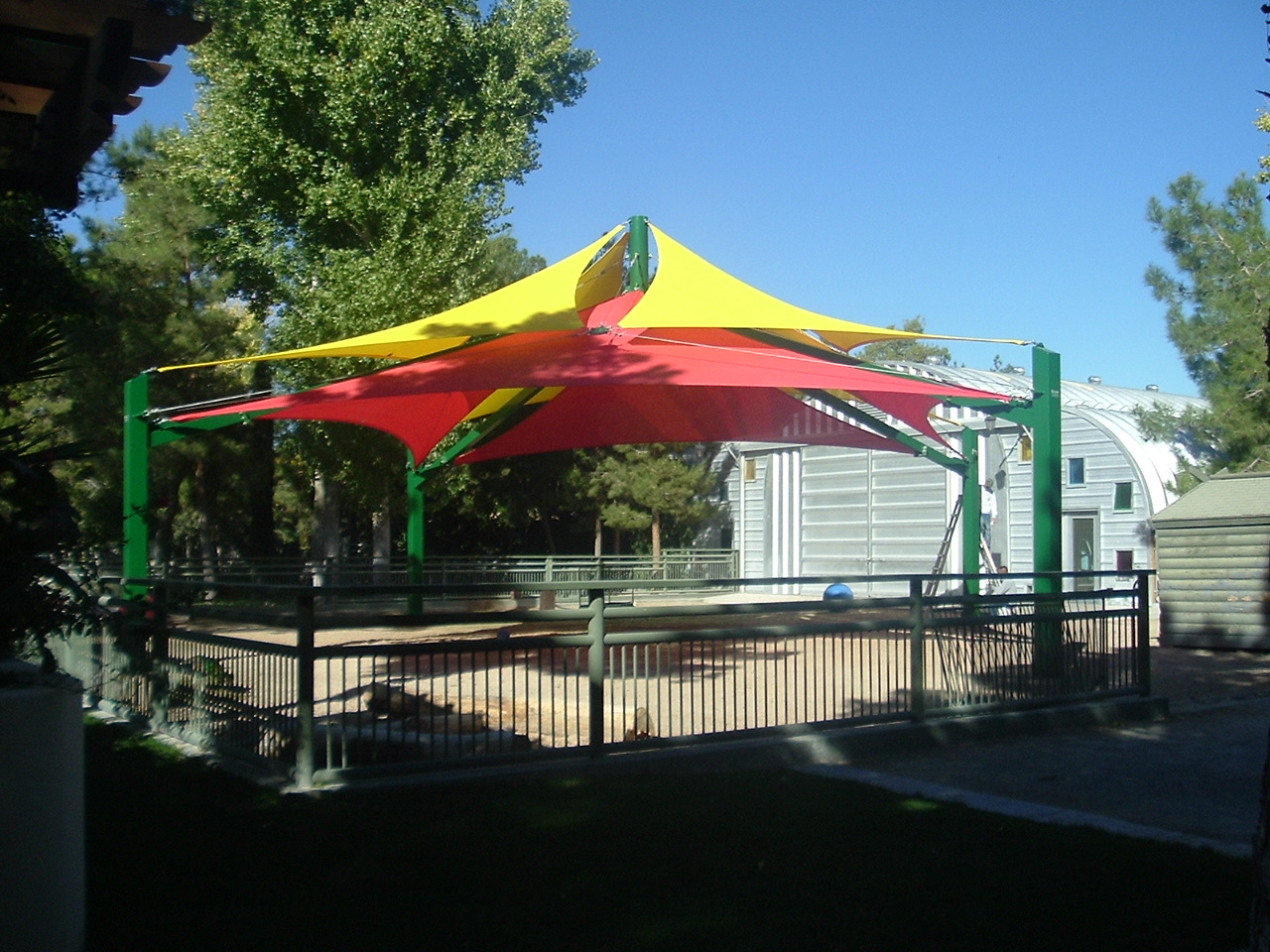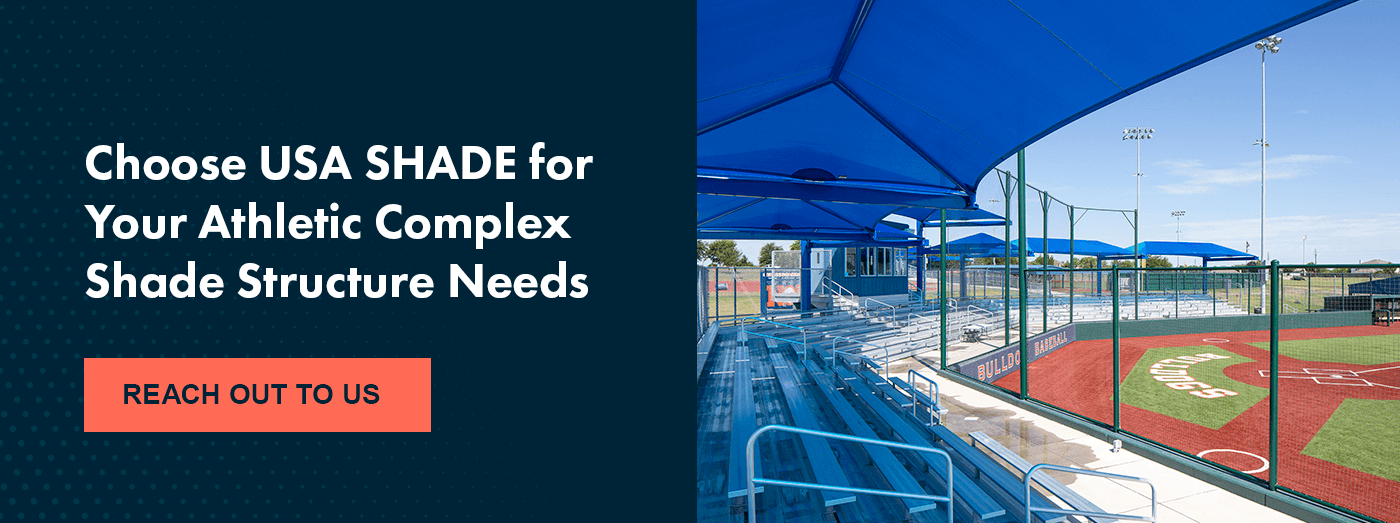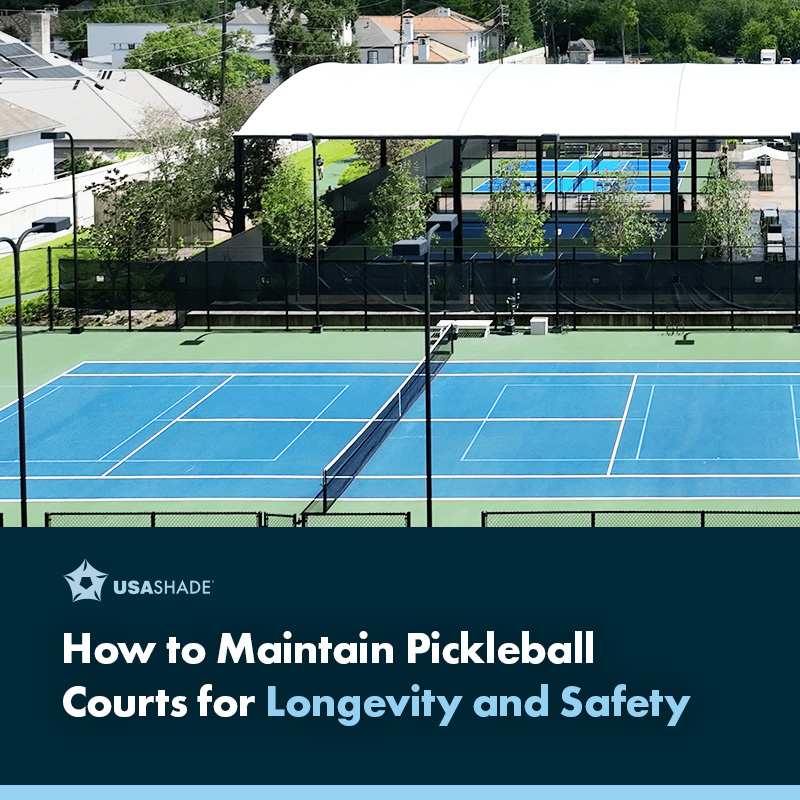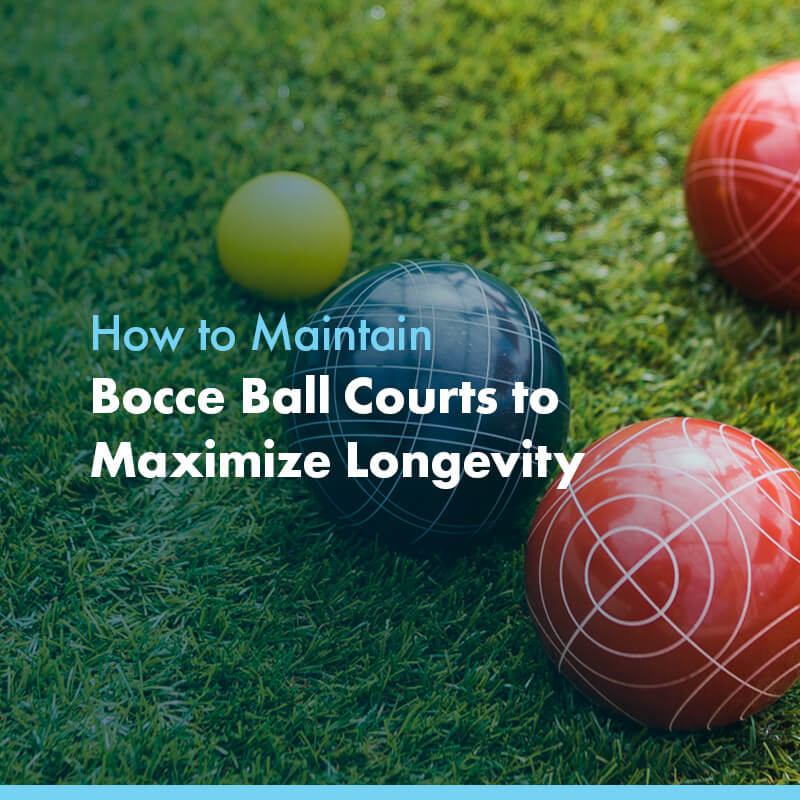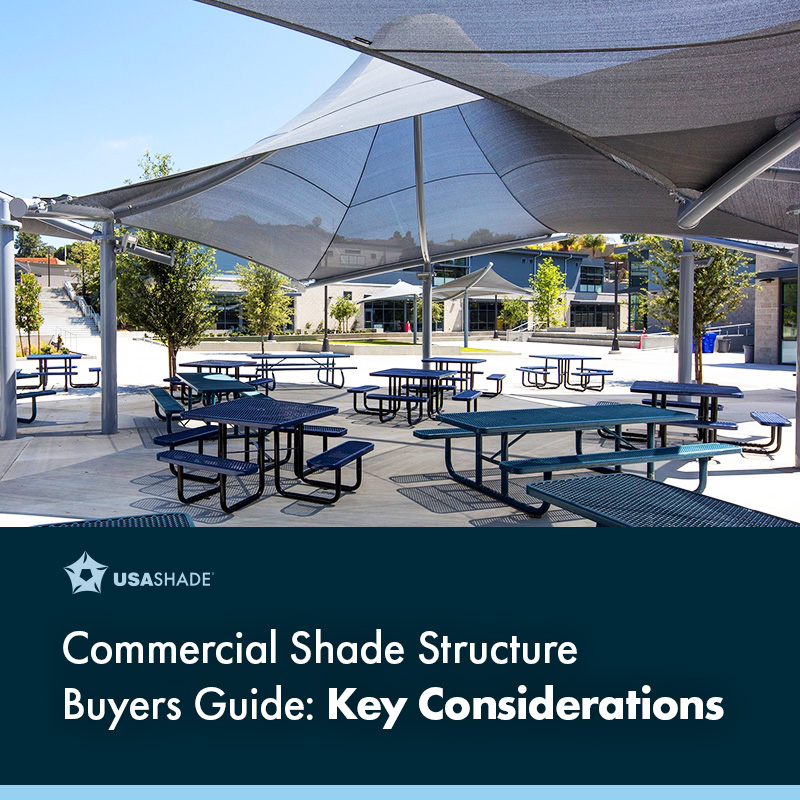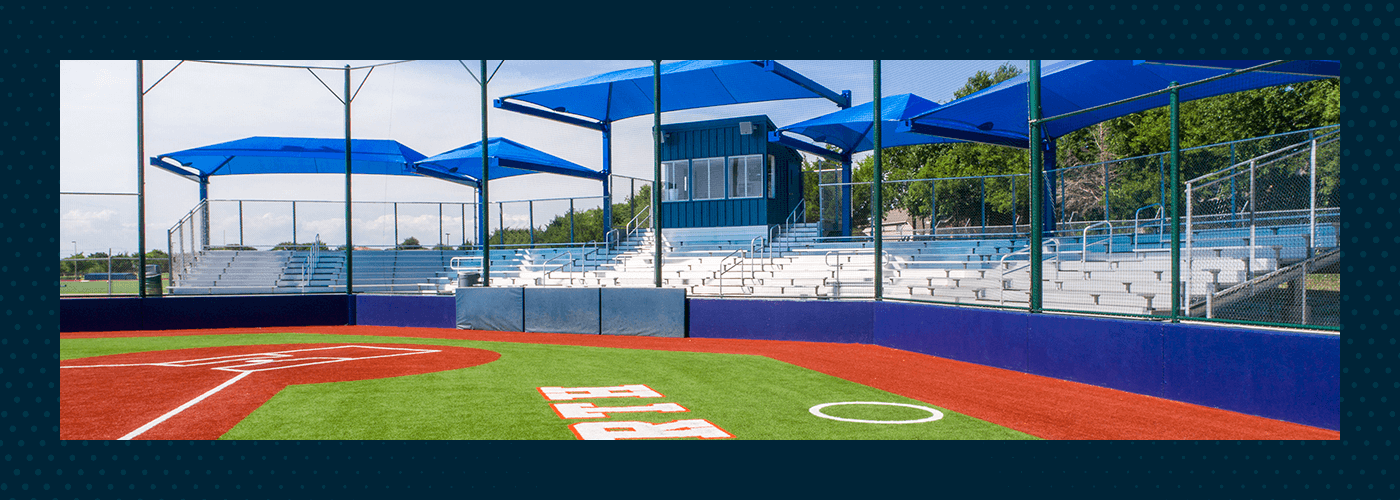
Designing and building a new sports complex is an impressive achievement. Sports complexes create buzz, adding to a community’s well-being, economy and connectedness. However, balancing all the elements that go into sports facility design can be challenging.
It’s natural to want to demonstrate your commitment and expertise when designing a sports facility. However, there are many considerations to work through to realize your goals, from the needs of your user base to the types of sports you host and shade for your sports complex. With many factors playing into your design decisions, it’s best to have a solid strategy in place from the outset.
An Introduction to Sports Complex Design
Sports are an American pastime, with 38% of Americans following a professional or college sport. In addition to spectating, many participate in sports at various levels, from grade school and high school to college and into their adult lives. With so many people watching or participating, indoor sports complex design is a competitive and nuanced field.
In addition to practicality and flow, your design should create a sense of place, reflecting the values and traditions of each sport and providing visitors with a familiar and welcoming venue. Each feature requires thoughtful planning to create a cohesive experience for everyone who walks through the doors. You’re designing for longevity, so each space should be agile, flexible and purposeful.
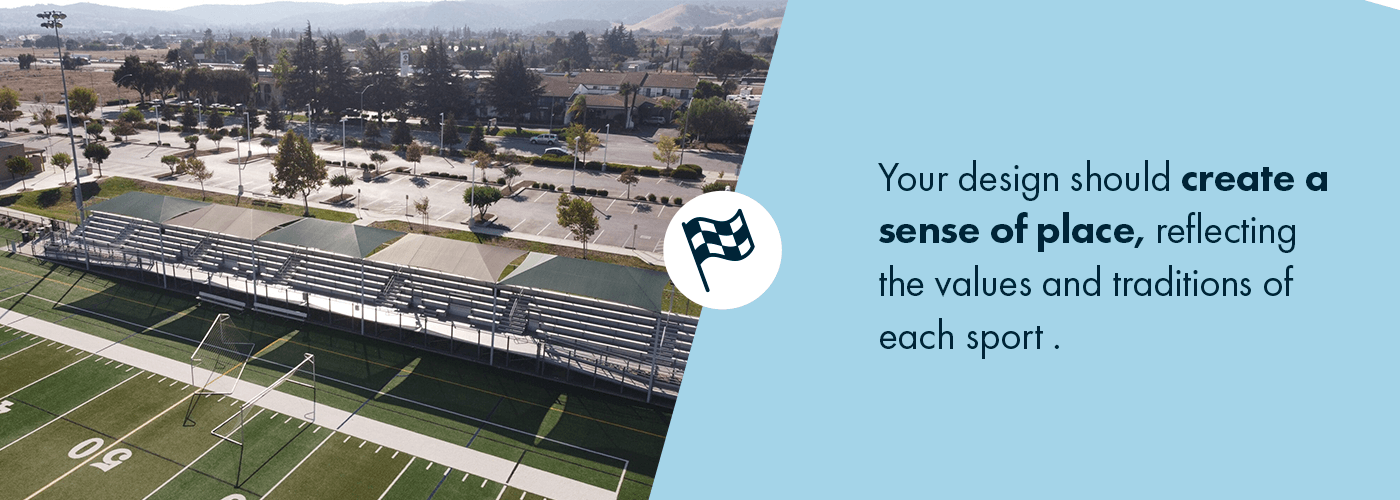
Although many factors go into architectural sports complex design, some overarching considerations include:
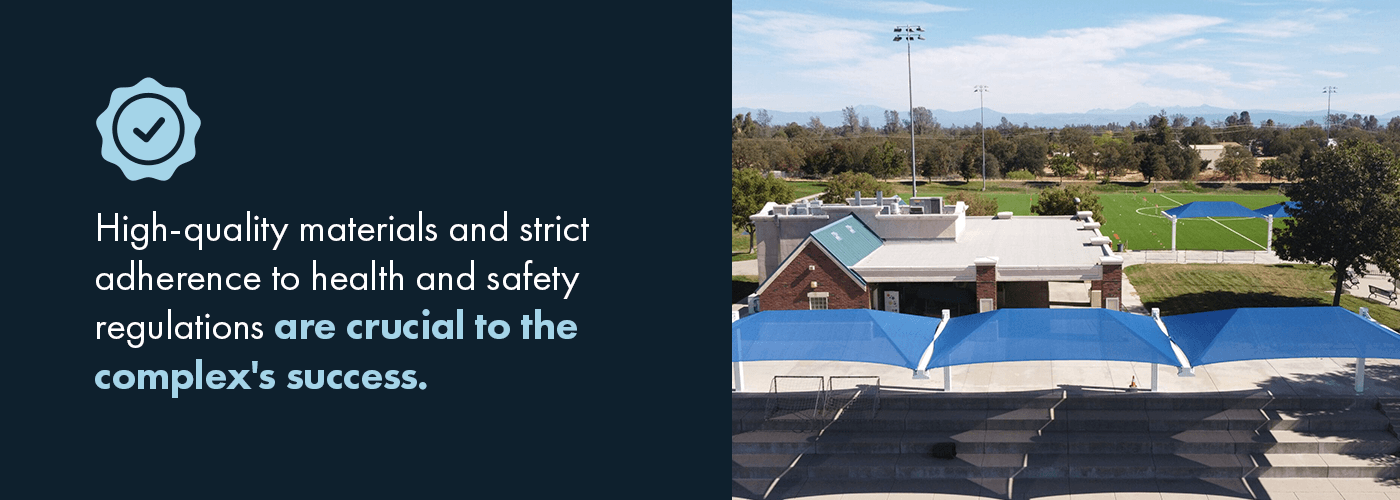
- Safety: Safety is perhaps the most critical consideration in any design. High-quality materials and strict adherence to health and safety regulations are crucial to the complex’s success.
- Accessibility: A sports complex should be accessible to everyone, regardless of age or physical ability. Incorporating elements like accessible ramps and wide doorways from the outset is vital to make movement flow through the building and its surroundings. In addition to maintaining compliance, accessible design ensures that everyone can engage in the experience your design creates.
- Sustainability: Modern sports complexes focus on reducing their environmental impact while maintaining functionality and efficiency. A sustainable design integrates eco-friendly materials and energy-saving technologies to reduce operational costs and align with the growing consumer demand for environmental responsibility.
Types of Sports Complexes
When designing a sports complex, the first consideration is which type best suits your business goals. Three main types of sports complexes exist, each with advantages and drawbacks.
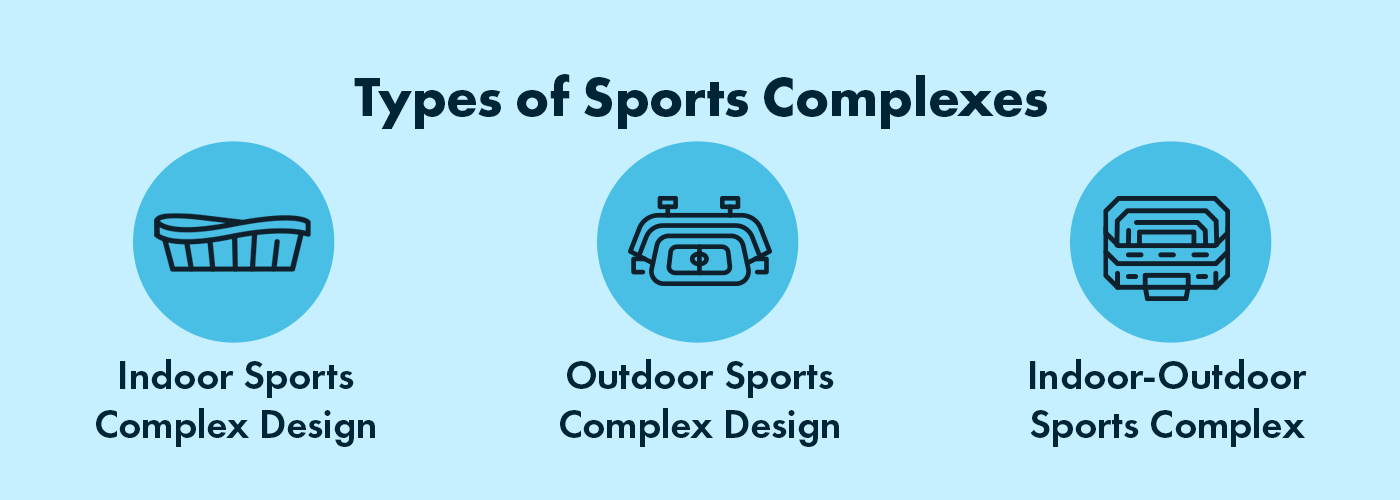
Indoor Sports Complex Design
An indoor sports complex is designed to house various activities within an enclosed, climate-controlled environment. This design offers several benefits, including:
- Weather independent and extended hours: Athletes and spectators can continue with play, regardless of the weather. They can also enjoy the environment for longer, as the facility can operate at any time of the day or night.
- Consistent environment: Athletes and spectators can enjoy controlled temperatures, lighting and humidity, which creates a comfortable and predictable environment for play.
- Reduced maintenance: Limited exposure to the elements can reduce wear and tear on surfaces and sports equipment.
Some of the drawbacks of an indoor sports complex include:
- Higher construction and operating costs: Enclosing a large space requires a significant investment in lighting, HVAC systems and construction materials. In addition, energy consumption for climate control and lighting can be substantial.
- Limited space: Indoor sports complexes offer an enclosed space, which may restrict the size and layout of certain sports facilities.
- Air quality and noise level concerns: Indoor sports complexes can be noisy, especially when multiple activities occur simultaneously. Proper ventilation is crucial to maintain air quality and prevent the buildup of odors.
Outdoor Sports Complex Design
An outdoor sports complex is a vast collection of outdoor sports fields, courts and facilities. Designing an outdoor sports complex offers considerable advantages, including:
- Maximized space: You can often incorporate more sports fields and courts in an outdoor facility, offering larger layouts.
- Natural environment: Athletes and spectators can enjoy time in a natural, outdoor setting, which often enhances the overall experience.
- Lower construction and operating costs: Outdoor sports facilities are often less costly due to the absence of an enclosure and climate control system. They also offer reduced energy consumption compared to indoor alternatives.
Despite these benefits, there are also disadvantages to consider. They include:
- Weather dependence: The weather can limit the use of an outdoor sports complex. However, you can install waterproof shade structures to keep spectators comfortable in the rain.
- Seasonable limitations: If you’re designing a structure in a location where it snows, your guests may face seasonal limitations due to inclement weather or daylight hours. A hot or humid environment can be unpleasant, but you can incorporate aesthetically pleasing shade structures to cover athletes and spectators during summer.
- Higher maintenance: The surfaces and equipment face exposure to the elements, requiring regular maintenance. Again, shade structures are integral to prolonging their service life.
Indoor-Outdoor Sports Complex Design
An indoor-outdoor sports complex is a hybrid facility that combines indoor and outdoor spaces to offer a wider range of activities and sports. They provide considerable positives, including:
- Versatility and flexibility: These complexes offer the benefits of indoor and outdoor facilities, catering to a broader range of sports, spectators and weather conditions. They can adapt to seasonal changes and user preferences and shift activities between indoor and outdoor areas.
- Increased revenue potential: As these complexes offer a range of sports modalities, they attract more visitors.
- Unique training opportunities: Athletes can train in controlled environments and outdoors, leading to improved all-around competition skills.
These versatile properties offer many advantages. However, it’s essential to consider the disadvantages, which include:
- High upfront investment: Significant land and construction are required to build these facilities, which leads to a higher initial investment.
- Complex management and maintenance: Managing indoor and outdoor spaces requires more staff and resources. In addition, maintaining indoor and outdoor surfaces can be demanding.
- Schedule conflicts: Scheduling and coordinating events between both spaces can be challenging.
How to Design a Sports Complex — Key Considerations
Once you have decided on the type of sports complex that best suits your space, you can begin with the design. Sports complexes can be challenging due to the many factors you need to consider besides architecture. Some of the primary considerations in the design phase include:
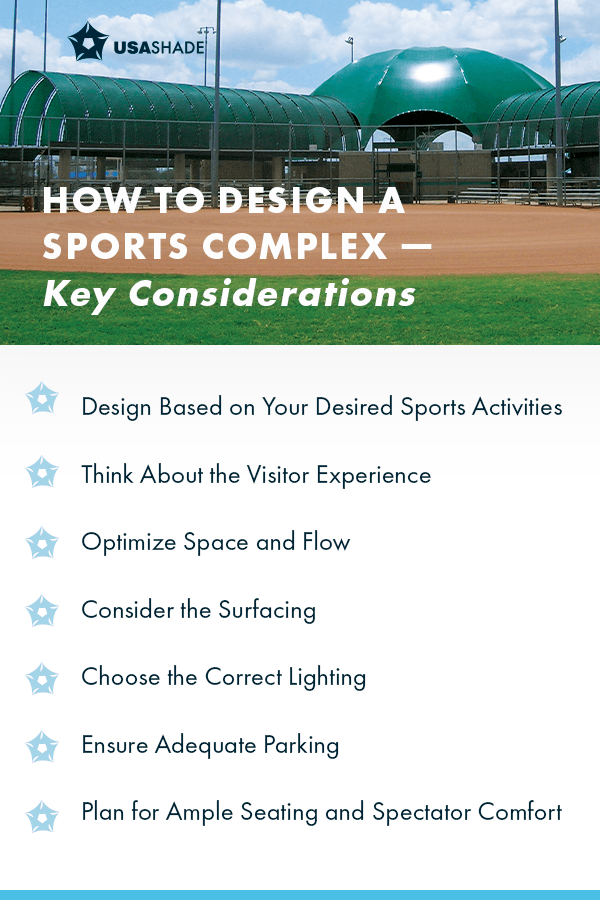
Design Based on Your Desired Sports Activities
Choosing the types of activities your facility will host is an exciting first step and an essential element of the design phase. Every sport requires unique facilities, which means focusing on a flexible design that caters to as many as possible. Focus on the following sports amenities:
- Baseball: Baseball fields add an exciting element to any sports complex. As a bonus, you can also host softball teams using your baseball field, allowing you to showcase two sports in one location.
- Basketball: Basketball is an immensely popular sport for people from all backgrounds, whether it’s a backyard game with a single hoop or a massive gym. Many types of sports complexes can integrate a basketball court, as participants can play on virtually any surface. You can use a basketball court for pickup games, tournaments and local leagues, making them versatile and more likely to draw the crowds.
- Soccer: Soccer fields in sports complexes are popular for schools, youth leagues and other groups. Soccer fields can be anywhere between 100-120 yards long and 55-75 yards wide. Accommodate these dimensions in your design from the outset to ensure you engage this target market.
- Football: Football fields are highly versatile. You can use them for many versions of sports and games, making them an excellent addition to any sports complex.
- Raquetball: Raquetball is a fun, casual game that appeals to many demographics. These courts should be around 20 feet wide, 20 feet high and 40 feet long.
- Tennis: Tennis always draws crowds and sports enthusiasts. You can choose from many surfaces, including grass, clay and hard courts. The latter are often the best choice due to their user-friendliness, durability and minimal maintenance requirements.
Your organization may also include amenities and facilities that complement sports. Added aspects of the complex can include:
- Swimming pools
- Locker rooms
- Shade structures
- Restrooms
- A fitness center
- Food courts
Think About the Visitor Experience
Successful sports complexes cater to both athletes and spectators. Consider the following points to provide the best experience for every visitor:
- Athletes: While your complex design should create a standout spectator experience, they will only have something to watch if you meet each athlete’s needs. Your design must consider the sports you want to host and what those players require to compete successfully. Athletes will likely come back when you offer every amenity that they want. In addition to premium surfaces, consider changing areas, locker rooms and athlete parking.
- Spectators: Spectators want comfort, convenience and entertainment when they visit a sports complex. Your design should allow for an easy flow of spectators through the complex while hosting regular tournaments and events that draw crowds. Consider seating, accessible parking, food and drinks, and shade.
- Members: Your members will always have the highest expectations as they pay for using your facilities. Again, your design should focus on convenience and flow while considering their expectations. Provide fitness facilities, convenient parking, intuitive check-in and comfortable locker rooms. Focus on comfort and exclusivity throughout your design.
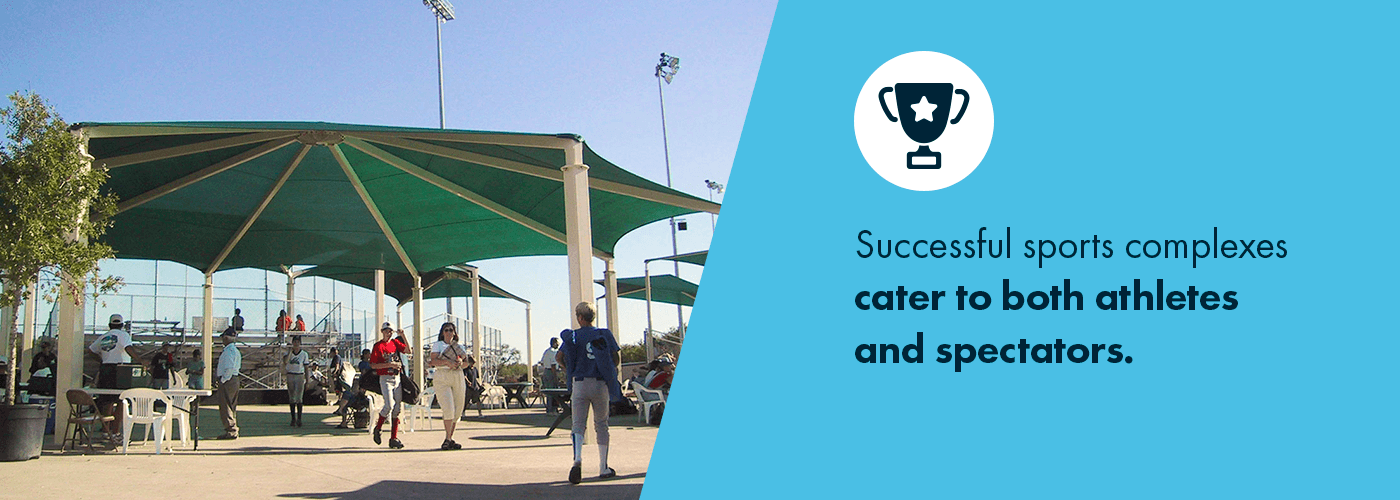
Consider the following questions to inform your design and improve the visitor experience:
- Who is going to use this complex?
- What sports will be played here?
- Will there be memberships?
- Are the facilities indoors or outdoors? Both?
- What will make an attendee’s experience more enjoyable?
- How many fields or courts should there be per sport?
While these questions aren’t exhaustive, always try to be reflective and ask questions that can help you anticipate the needs of users before they ever articulate them.
Optimize Space and Flow
Design flow, or the way people move through a building, is essential in any building design. In a sports complex, aim to help them move safely, efficiently and comfortably. Your design can create clear paths from place to place, eliminating unnecessary obstacles for athletes and spectators. Strategic layout planning is also essential for safety and accessibility. Consider the flow in every part of your design, from lighting to parking spaces, to ensure a streamlined experience for visitors.
In addition to flow, sports complex design can also optimize the available space. Sports involve a lot of equipment, which means storage is critical to the user experience. Focus on flexible and accessible multipurpose storage options so there is enough space for people to move freely and get what they need without feeling cramped.
Consider the Surfacing
The surfacing at your sports complex is another crucial design consideration. You have several options, and your choice depends on your chosen sports, type of sports complex and budget. The main surfacing options are natural and artificial turf.
1. Natural Grass
Natural grass is one of the top turf options. Some athletes prefer natural grass, as it’s generally a softer surface with more give to it, which can be easier on an athlete’s joints and knees. Natural grass may even be safer than artificial turf when playing a sport like football.
The cons to natural grass come down to its durability and how it performs in inclement weather. For example, natural grass can become muddy and slick, making it hard to play on, and the chances of injury increase. Even in perfect weather, natural grass requires consistent maintenance, as grass can grow too high or get kicked up. Replanting grass, watering it and mowing it will be consistent tasks for those with natural grass for turf.
2. Field Turf
Innovations in artificial turf make it easy to have a low-maintenance lawn with the all-natural look and feel of grass. With artificial turf, you do not need to mow, weed or fertilize the grounds. Although you don’t need to water artificial turf — making it an environmentally friendly option — you should rinse it about once a week to keep it clean, hygienic and odor-free. Artificial turf is designed with irrigation systems that drain water from cleaning and rain.
This kind of artificial turf tries to mirror the way natural grass feels. It’s softer than other turf options, as it’s made out of polyethylene blades and crumb rubber. Since it’s artificial, you won’t have to worry about mowing, and its irrigation systems will handle any draining that would normally hamper a natural grass field, leading to lower maintenance costs.
This kind of artificial surface also saves money due to its low maintenance costs. If you’re trying to be more environmentally friendly at your facility, a major bonus of field turf is that you don’t have to waste any water that would go toward watering natural grass throughout the year. One of the downsides to field turf is how hot it can get playing on it. In fact, it’s been reported that on a 98-degree day, turf can be up to 200 degrees. Additionally, some bacteria can survive on turf for over 90 days, due to the polyethylene plastic used for the blades. This can be a cleanliness concern if a facility doesn’t regularly wash its turf.
Choose the Correct Lighting
Spectators and players alike enjoy evening and night games. Visitors love attending events at convenient hours, and athletes enjoy the coolness of the night for high-cardio games. Your company’s sports complex can also be more accessible to people who want to get a game after work hours.
Adequate lighting is essential for keeping the fun going after the sun goes down. Your lighting needs will vary depending on the sport you’re accommodating, the size of your complex and your budget. Working with a lighting expert makes it easy to figure out the coverage you need. To save money and get more life out of your lights, choose LED bulbs over traditional ones — they provide long-term energy savings and tend to have a longer life span.
Ensure Adequate Parking
Secure and accessible parking is key to making your athletic complex accommodating. Sufficient parking can increase attendance and boost membership and visitor satisfaction. When you have the capacity to host large tournaments and events, your facility becomes a popular attraction for sporting event organizers.
When designing your complex, it’s wise to consider the demand of the sports you are tailoring your complex to. Getting a feel for the community’s interests and needs could give you insight into how busy your facility may get during big matches. Your complex will need enough parking for teams, hosts, players, coaches and crowds.
When you plan your parking area, it’s also helpful to consider the following points:
- The number of team buses and vans your facility wants to accommodate.
- The distance from the parking area to the reception, courts and amenities.
- Designated parking for teams and coaches, emergency vehicles, people with disabilities, and members.
- Shade structures for covered parking.
- Various ways to secure the parking area and mitigate liabilities.
Plan for Ample Seating and Spectator Comfort
Legacy sports complexes focused on getting as many spectators as possible, with minimal considerations for comfort. Today, the user experience is more important than ever, and the right seating creates a better experience, enhancing loyalty and promoting repeat attendance. Your choice of seating depends on your space and budget. However, consider the following to ensure a positive return on investment and the best possible experience for each visitor:
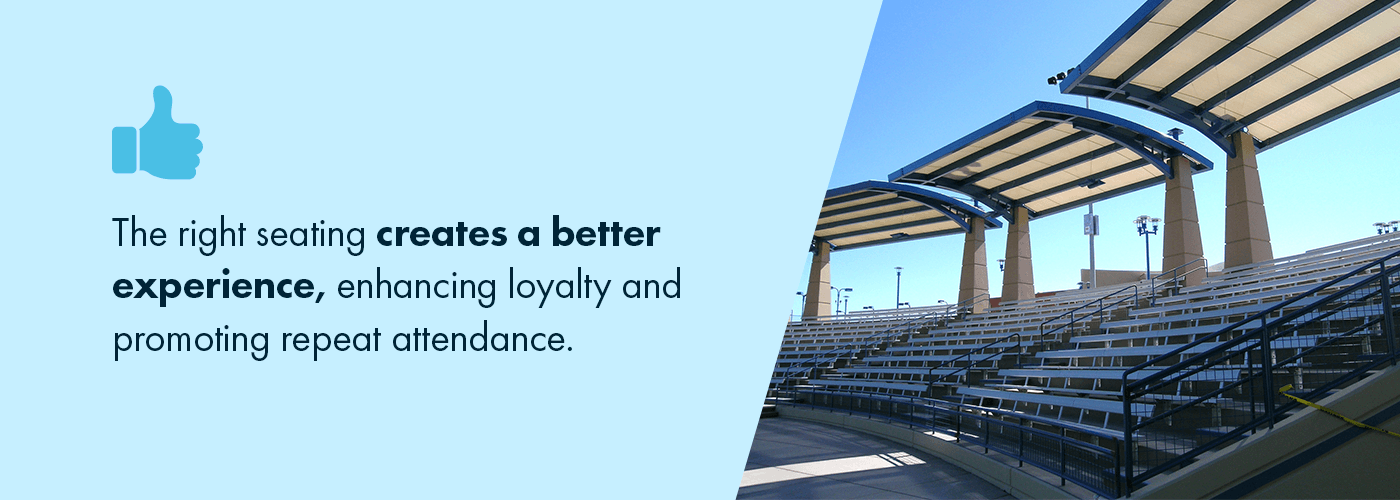
- Durability and longevity: Choose durable and long-lasting seating materials. If you have an outdoor or indoor-outdoor venue, your seating will be prone to wear from the elements. Opt for materials that can withstand all weather conditions and install shade structures to limit weather damage.
- Capacity: The number of people you plan to hold in your sports venue also has a bearing on seating and comfort. For example, grandstands and high-capacity bleachers seat large numbers but require spectators to be closer together.
- Sightlines and views: Most spectator seating is elevated to provide a cohesive viewing experience. Consider providing the best sightlines possible to keep people seated during games.
- Protection from the heat: Having shade for your sports complex is essential to protect spectators and athletes from the heat. You can choose versatile shade structures that also protect them from the rain, keeping the activities in motion.
You’ll get many types of visitors to a sports complex, including fans, athletes, coaches, administrators and staff. The key is to find ways to cater to each potential user. Empathy mapping is a productive strategy for this design consideration, helping to ensure the final design accounts for as many users as possible.
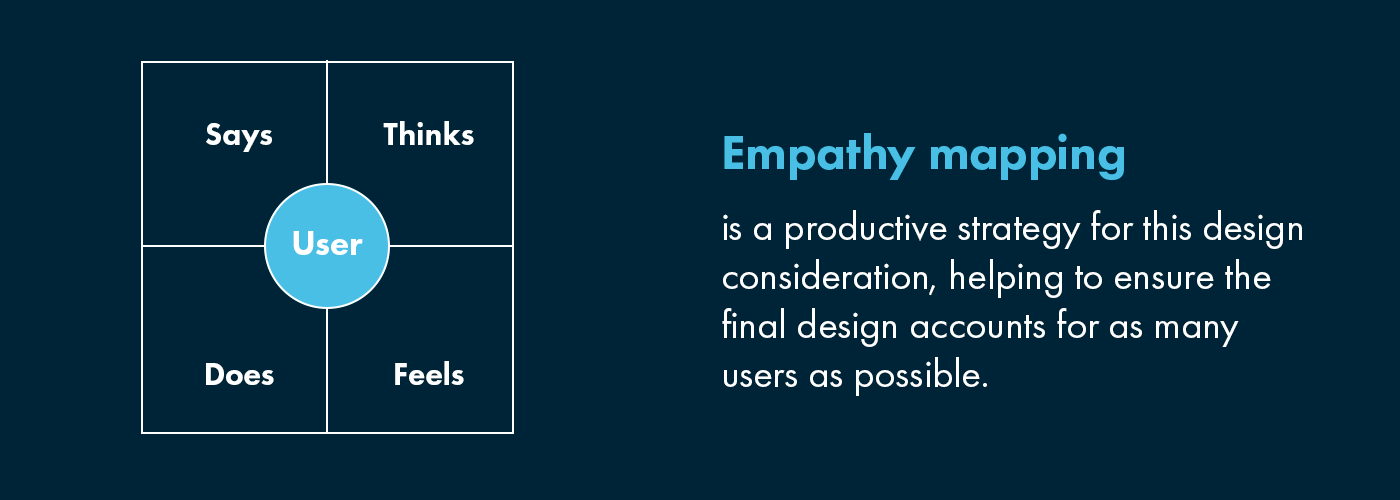
Common Challenges of Designing Athletic Complexes
Building a sports complex is no doubt rewarding, but the construction does come with its own set of challenges and solutions:
- Strict deadlines: Design and construction projects typically face strict deadlines. Consider when associations host events for the sports you are designing for during your planning phase. For example, typical basketball and football seasons fall between August and May. Aim to set your deadline before the next sporting season and pay close attention to dates if you will host sports with different seasons.
- Space constraints: Space is always a concern whether you are building an indoor or outdoor facility. The key is balancing sports requirements with the area you have. You will also need to include sufficient space for amenities and parking. Working closely with an architect will give you excellent insights and eliminate a ton of perceived challenges.
- Compliance requirements: Understanding building regulations and compliance laws is essential for ensuring your plans go ahead smoothly. The best place to start is to have your design team, architects and contractors meet with your town planner or zoning department so they can approve your plans.
Tips to Keep Guests Coming Back to Your Sports Complex
Even before your complex opens to the public, you can brainstorm ways to generate interest and increase the chances of guests coming back or taking up membership.
1. Plan to Host Tournaments
During your company’s building phase, you can reach out to the event organizers to form relationships and let them know that your facility will host tournaments. Your team can also get in touch with local sports clubs and schools depending on the events you want to host.
With premium fields and courts, adequate parking, comfortable seating and convenient amenities, your sports complex can become the community’s go-to destination for tournaments and special events.
2. Respond to Feedback
Social media is a fantastic tool for marketing and discovering your audience’s needs and preferences. As you start the design phase, reach out on social media to get a feel for what the community wants, and do your best to incorporate their suggestions into your plans.
Once you have built the complex and guests are using it, be open to feedback so you can keep impressing athletes, members and visitors.
3. Use Shade Structures Outdoors
Even the most dedicated athletes and spectators want relief from the blistering summer heat. Many athletic complexes install shade structures to keep people returning to the facilities. Adding shade structures to your sports complex has several benefits:

- Safety and durability: Professionally designed shade structures are crafted specifically for athletic applications. They comprise a robust steel framework and durable materials that withstand many weather conditions, including excessive heat, wind and rain.
- Comfort and protection: In addition to providing athletes and spectators with protection from harmful ultraviolet rays, shade structures also protect athletes’ well-being, giving them a place to cool off. Spectators can enjoy the sport in comfort, making them more likely to attend games and stay longer on hot days.
- Aesthetic appeal: Shade structures are more than functional. They add a cohesive architectural elegance to your sports complex. They can transform the look of the area and improve the intrinsic value of your complex.
- Equipment longevity: Shade structures protect surfaces and equipment just as they protect people, making your investment last longer.
Choose USA SHADE for Your Athletic Complex Shade Structure Needs
If your business has an outdoor or indoor-outdoor sports complex, you can enhance its design by adding shade sail and cantilever structure solutions throughout the grounds. Trust USA SHADE for all your shade structure requirements, from tennis court shade solutions to basketball court shade structures and more.
Our structures improve the appearance of your facilities and provide shade throughout. As a proven leader in fabric structure design and technology, we offer in-house experts to help you choose a shade structure to suit your needs, including waterproof structures for outdoor applications.
USA SHADE is proud of our custom approach, which makes it easy for you to find a structure that fits your vision for your sports complex. Contact us today with any questions, request a free quote or check out our Architecture Lookbook for even more design inspiration.


